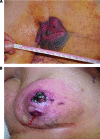Radiation-induced sarcoma of the breast: a systematic review
- PMID: 22334455
- PMCID: PMC3316927
- DOI: 10.1634/theoncologist.2011-0282
Radiation-induced sarcoma of the breast: a systematic review
Abstract
Introduction: Radiation-induced sarcoma (RIS) is a rare, aggressive malignancy. Breast cancer survivors treated with radiotherapy constitute a large fraction of RIS patients. To evaluate evidenced-based practices for RIS treatment, we performed a systematic review of the published English-language literature.
Methods: We performed a systematic keyword search of PubMed for original research articles pertaining to RIS of the breast. We classified and evaluated the articles based on hierarchical levels of scientific evidence.
Results: We identified 124 original articles available for analysis, which included 1,831 patients. No randomized controlled trials involving RIS patients were found. We present the best available evidence for the etiology, comparative biology to primary sarcoma, prognostic factors, and treatment options for RIS of the breast.
Conclusion: Although the evidence to guide clinical practice is limited to single institutional cohort studies, registry studies, case-control studies, and case reports, we applied the available evidence to address clinically relevant questions related to best practice in patient management. Surgery with widely negative margins remains the primary treatment of RIS. Unfortunately, the role of adjuvant and neoadjuvant chemotherapy remains uncertain. This systematic review highlights the need for additional well-designed studies to inform the management of RIS.
Conflict of interest statement
Section Editors:
Reviewer “A”: None
Figures



References
-
- Fisher ER, Anderson S, Redmond C, et al. Ipsilateral breast tumor recurrence and survival following lumpectomy and irradiation: Pathological findings from NSABP protocol B-06. Semin Surg Oncol. 1992;8:161–166. - PubMed
-
- Yap J, Chuba PJ, Thomas R, et al. Sarcoma as a second malignancy after treatment for breast cancer. Int J Radiat Oncol Biol Phys. 2002;52:1231–1237. - PubMed
-
- Fodor J, Orosz Z, Szabó E, et al. Angiosarcoma after conservation treatment for breast carcinoma: Our experience and a review of the literature. J Am Acad Dermatol. 2006;54:499–504. - PubMed
-
- Velaj RH, DeLuca SA. Radiation-induced sarcoma. Am Fam Physician. 1987;36:129–130. - PubMed
-
- Erel E, Vlachou E, Athanasiadou M, et al. Management of radiation-induced sarcomas in a tertiary referral centre: A review of 25 cases. Breast. 2010;19:424–427. - PubMed
Publication types
MeSH terms
LinkOut - more resources
Full Text Sources
Medical

